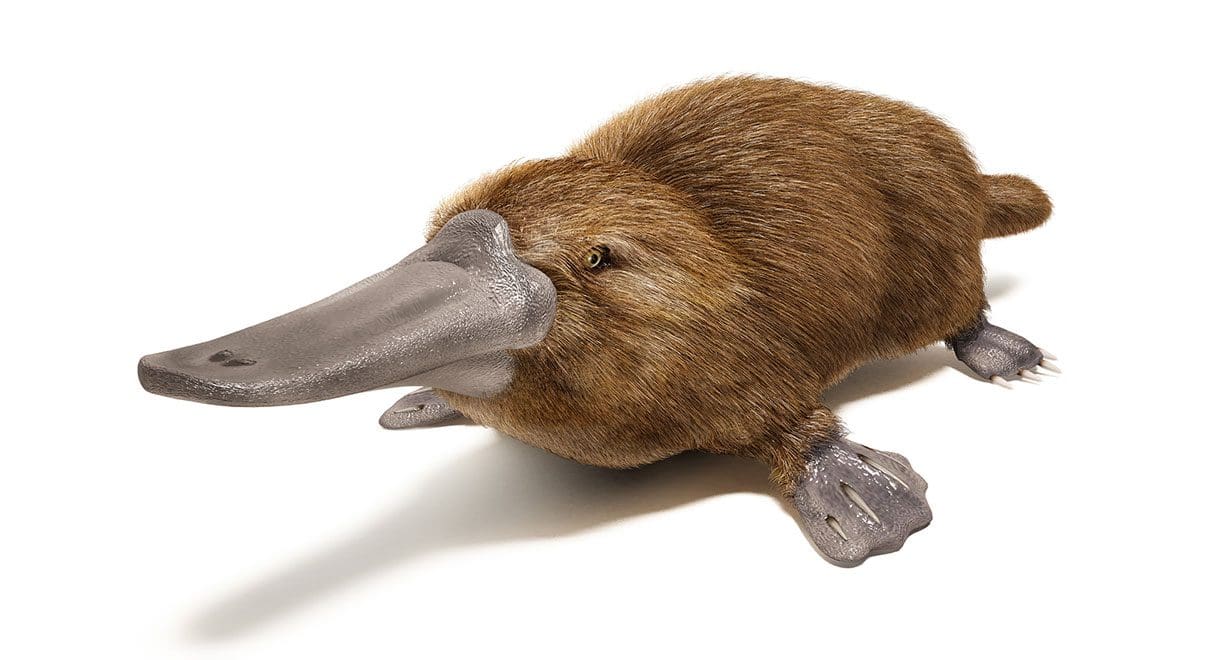

The body is somewhat flattened and streamlined. As the platypus dives, the two fur layers trap a layer of air next to the skin, thus keeping the body dry and helping to insulate it against cold while the platypus swims, often throughout the night, and sometimes in temperatures close to freezing. The fur has two layers, an undercoat with a woolly texture and an overcoat of coarser hair. Platypus fur is fine, soft, and dense, with up to 900 hairs per square inch of skin. The pelt color varies from dark amber to very dark brown on the platypus's back and sides, and from grayish white to yellowish brown on the underbelly. Most of the body is covered with fine, soft fur. The scientific name, Ornithorhynchus anatinus, means, in Latin, "bird-snout, resembling a duck." The plural is "platypuses" or just "platypus." The word "platypus" means "flat feet," referring to the animal's webbed, somewhat ducklike feet. The nostrils are set close together on the top of the upper bill. The bill has an upper and lower section, like that of a mammal or bird, and the jaw hinging and motions are like those of mammals. The snout, despite its duckbill shape, is soft, moist, and rubbery in texture, not hard like a bird's beak. An adult platypus, about the size of a house cat, weighs from 3 to 5 pounds (1.5 to 2.5 kilograms), its adult head and body length runs 12 to 18 inches (30 to 45 centimeters), and the tail adds another 4 to 6 inches (10 to 15 centimeters). Journal of Venomous Animals and Toxins including Tropical Diseases, 19(1), 21.DUCK-BILLED PLATYPUS: Ornithorhynchidae PHYSICAL CHARACTERISTICSĪ platypus, at first glance, resembles an otter with a duck's bill on its face and a beaver's tail in back.

Mad, bad and dangerous to know: the biochemistry, ecology and evolution of slow loris venom. Poisonous platypuses confirm convergent evolution. An utter odd ball: a platypus spotted in a Tasmanian creek. Who would have thought the combination of a duck bill and beaver tail could prove so successful? The platypus really is one unusual animal. So despite its adorable, odd-ball appearance, the platypus really packs a punch. One man who was jabbed on the finger had pain in the area up to four months later!
%2Bhead%2BSU.jpg)
In humans it causes instant and excruciating pain that can’t be relieved by morphine and other first aid methods. In the spring breeding season the male’s venom glands swell and produce more venom, and you definitely don’t want to receive a dose of it. This just means they produce venom differently at different times of the year. Venomous mammals are rare enough – beside the platypus there are perhaps only seven other species, but the platypus is also the only known animal to exhibit temporally differential venom production. Platypus males have another secret weapon too, a highly potent venomous spur found on each of their hind legs. In the platypus male the left head of the penis is the one that is larger and more exaggerated, supposedly helping to better target the egg producing ovary. The females have two ovaries but only the left is functional and produces eggs. Australian National University, Canberra.Īs you can see above, the platypus penis is quite specialised! While its shape and structures are still not fully understood, scientists have noticed it nicely reflects what’s going on inside the female platypus. Both lay eggs, both have a single opening for all their waste stuff and sex stuff, both walk like reptiles (as explained in my echidna post), and both have multi-headed penises… Photo source: Temple-Smith, P., (1973) Seasonal breeding in the platypus, with special reference to the male. It’s the echidna! While not physically very similar looking, functionally they are.

So despite the platypus’s duck-like bill and beaver-like tail, its closest relative isn’t either of these. In these odd organisms, the males actually have a double headed penis and a highly venomous spur. A quick recap: monotremes are the egg laying mammals and there are only three species – two types of echidna and a single species of platypus found only in Australia. I wrote about the echidna in an earlier post and thought it only fair to write one for that other equally odd Australian monotreme – the platypus.


 0 kommentar(er)
0 kommentar(er)
